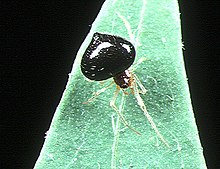Chikunia is a genus of Asian comb-footed spiders that was first described by H. Yoshida in 2009.[2] These spiders are small, often dark or orange colored. This species can be found in solidarity, though they can also be found in colonies.[3]
| Chikunia | |
|---|---|

| |
| Chikunia albipes | |
| Scientific classification | |
| Domain: | Eukaryota |
| Kingdom: | Animalia |
| Phylum: | Arthropoda |
| Subphylum: | Chelicerata |
| Class: | Arachnida |
| Order: | Araneae |
| Infraorder: | Araneomorphae |
| Family: | Theridiidae |
| Genus: | Chikunia Yoshida, 2009[1] |
| Type species | |
| Chikunia albipes (Saito, 1935)
| |
| Diversity | |
| 3, see text | |
Colonies
editThe species C. bilde and C. nigra are unique for spiders, as they are capable of forming intra-species colonies, both spiders being each others closest relative. Both species care for their young, and are thought to do the same to their neighbor's young. These colonies can be around 100 strong, with each adult keeping a distinct territory inside the colony. Another question raised by this unique arrangement, is the fact that they are both genetically distinct species.[3][4]
Species
editAs of May 2020[update] it contains three species, found in Asia:[1]
- Chikunia albipes (Saito, 1935) – Eastern Russia, China, Korea, Japan
- Chikunia bilde Smith, Agnarsson & Grinsted, 2019 – Malaysia, Singapore, Indonesia
- Chikunia nigra (O. Pickard-Cambridge, 1880) – India, Sri Lanka to Taiwan, Indonesia.
See also
editReferences
edit- ^ a b "Gen. Chikunia Yoshida, 2009". World Spider Catalog Version 20.0. Natural History Museum Bern. 2020. doi:10.24436/2. Retrieved 2020-06-12.
- ^ Yoshida, H. (2009), "Three new genera and three new species of the family Theridiidae", in Ono, H. (ed.), The spiders of Japan with keys to the families and genera and illustrations of the species
- ^ a b Smith, Cassandra; Cotter, Addie; Grinsted, Lena; Bowolaksono, Anom; Watiniasih, Ni Luh; Angarsson, Ingi (2019). "In a relationship: sister species in mixed colonies, with a description of new Chikunia species (Theridiidae)". Zoological Journal of the Linnean Society. 186 (2): 337–352. doi:10.1093/zoolinnean/zly083. Retrieved 2023-02-23.
- ^ University of London (2019). "New species of spider discovered with unusual social skills". Royal Holloway. Retrieved February 22, 2023.